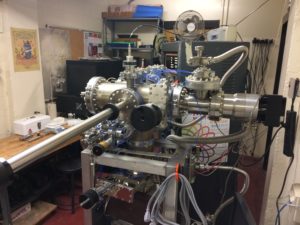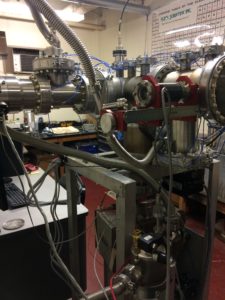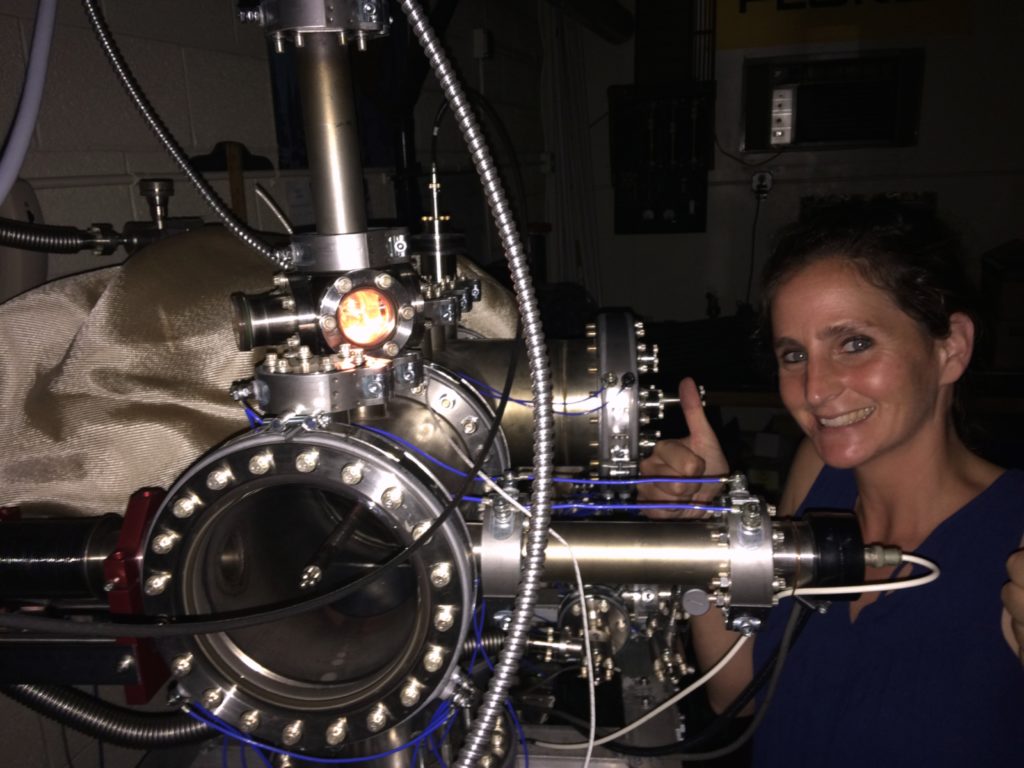This page is meant to serve a couple of purposes. First, it’s intended to highlight some of the accomplishments students have achieved and exhibit some of the directions in which their research interests have pushed mine. Second, I hope that seeing what kinds of projects students have been able to undertake in my research effort will enable students shopping around for a research experience to make informed choices.
The topics are sort of chronologically listed by the time each one started. Everything on the page is still ongoing or at least put on the back-burner until/unless an interested student comes along.
Get in touch if you’re interested in joining the lab. I may not have a pre-packaged project for you to work on, but I’ve never turned down a student who brought a research project to me looking for an advisor.
Li-ion Batteries
This is a big topic. We play a small role in a large collaboration involving researchers at the University of Rhode Island, Brown University, NIST, Brookhaven National Lab , and the Canadian Light Source. Right now, we’re focused on X-Ray Photoelectron Spectroscopies, but are working toward breaking into neutron scattering to make our contribution to the effort.
XPS/HAXPES Experiments
-
Alums: Chris Caldera, Steph Rivard
Chris Caldera and I developed some standard profiles of common compounds found in the solid electrolyte interphase (SEI) of lithium-ion batteries (LIBs). Our goal was to get some data for pure compounds and known mixtures of the compounds, then see if we could predict the XPS spectra we observed by adding combinations of the pure spectra together in the known proportions. He created a poster for presentation at the Sigma Xi / Honors Poster session at RIC detailing some preliminary findings, which were encouraging:
XPS Peak Deconvolution for Li-Ion Batteries by Chris Caldera. Chris’ research was featured on the Rhode Island College website in June 2015 – check it out!
Steph picked up where Chris left off and analyzed data from a recent high energy XPS (HAXPES) experimental run at the Canadian Light Source.
On 15 March 2017, RIC took over session L38 at the American Physical Society March Meeting in New Orleans.
We learned in November 2018 that our proposal to use the new synchrotron at NSLS-II has been granted beamtime. Looking forward to getting back to Long Island and Brookhaven National Lab over Spring Break 2019!
Nuclear Reactor – RINSC
Not many people realize it, but there is a nuclear reactor in lil Rhody. It’s housed at the Rhode Island Nuclear Science Center (RINSC) in Narragansett. It’s not the type that generates electricity but rather a research reactor – it produces neutrons that we can use to study things. The staff are in the process of a major revitalization of the research capabilities and we’re lending a hand.
-
Alum: Sara Pariseau
The immediate goals are to get a couple of neutron detectors on-line so that all users of the RINSC may benefit. We’re happy to learn some nuclear physics (and safety) as we do it. Sara designed detector housings, wrote experimental control programs in the LabVIEW visual programming language, and developed a few smaller experiments for the PHYS313/PHYS413 courses at RIC.
Sara left for her doctoral program at Lehigh University upon graduation in 2018, so this project is waiting for an interested student with the interest/ability to get to Narragansett.
In the longer term, I’d like to use neutron reflectometry (NR) to interrogate surfaces (like the passivation layers of LIB electrodes). Once we get the necessary expertise at RINSC, we’ll write a proposal to use a national lab to collect publication-quality data.
Aerogels
-
Alum: Ben Beaudoin
These fascinating materials are all the rage right now. Much like carbon nanotubes and graphene, there are a lot of applications and lots of people are working to find new ones. Aerogels are characterized by very low mass density and can be fabricated with tunable properties like conductivity, absorption, etc. After a few failed efforts, we have finally nailed the procedure for fabricating our own and Ben created his first aerogel in early January 2017. He finished up his degree but remains involved in the lab – we will be working with the chemists upstairs to run some tests on his gels when he’s satisfied with the product.
Ben’s project was a real beauty – he got interested in aerogels during the PHYS409 Solid State Physics course and proposed his own project. I was happy to mentor him because students learn more when they have “buy in” and knowing nothing about these materials when we started, I got to learn a bunch of cool new stuff as well.
Ultra High Vacuum
We’re building an ultra high vacuum (UHV) chamber in Clarke Science and I’m always looking for handy students who think they might like to learn about vacuum science to help out. When it’s done, I will investigate photon counting and do photoemission spectroscopy in some form. There’s a lot of work standing in the space between here and there. Various students have contributed to what’s already been built and opportunities exist to continue their work or take a new direction.
Current Chamber Status
Pressure: 1.3 x 10^-8 Torr
Atmospheric pressure is 7.6 x 10^2 Torr, so we’re over ten orders of magnitude (~100 billion) less than air!
-
Alum: Dave Robinson
Dave helped out quite a bit with good, old-fashioned elbow grease as we put components of the chamber together and learned about what it takes to maintain and sense a pressure about ten trillion times less than atmosphere. As we neared the end, we wired up a few electrical circuits and made a protection circuit to keep the turbomolecular pump safe in the event of a power outage.
Unfortunately (for us), Dave left for his Doctoral program at URI before we were able to see it all in action. In the summer of ’16 though, we got the necessary equipment to close up and turn on our pumps.
Here’s the rig in a few recent photographs:


This view shows the magnetic transfer arm that we’ll use to move the sample around as a lower cost alternative to a proper bellows-equipped z-axis manipulator.

Here’s the back of the chamber. The photon detector will slide into the red-framed bellows manipulator when it’s electropolished and welded.
Over the winter break 2016-2017, we finally installed and wired up the resistive heating bands that allow us to bake the chamber. At that point we had to wait on the College to put 208VAC service in the lab before we could turn on the ion pump and maintain UHV conditions.
The College dropped 208VAC electrical service in the lab in late Spring 2017 and we also got the turbomolecular pump fixed using some money from the battery grant.
-
Alumnus: Lisa Bucci, Joshua Santana, David Hernandez Rodriguez
Lisa joined up in Summer 2017 to do some work for her graduate certificate program. She built a temperature programmed desorption (TPD) spectrometer essentially from scratch! Due, surely, to the superlative preparation she received during her undergraduate time here at RIC, Lisa hit the ground running and baked the chamber to get us into the ultra-high vacuum regime, designed and implemented a sample holder that can heat our Si(100) crystal to over 1000K, and prepared to clean the crystal by ion bombardment en route to her first desorption spectra.
That summer we showed proof of concept for carbon dioxide desorbing from the silicon surface. Here’s a shot of Lisa on the day her sample holder passed muster:

Update: August 2018
Josh and David are building a temperature controller to predictably bake out the chamber when we need to. They’re both non-physicists, but have been plenty prepared in the intro course sequence to make meaningful contributions. They’re presently mounting the necessary equipment in a custom instrument they’ve built and will wire it up when finished using their PHYS102 chops. Once this is complete, we’ll be back in the ultra-high regime in no time. Controlling the bake to complete it as quickly as possible is crucial to decreasing the time we spend in a vulnerable state. Their work can’t be more important to the effort and we’re excited to get back to TPD studies when they’re done.
Ultrafast Dynamics in Photo Systems
-
Current Students: Jacqueline Escolastico, Nathan Girard
We’re proud to bring a new project to the group! Prof. Dugan Hayes (URI) and I have gotten funding to study ultrafast dynamics in photovoltaics and photo-catalysts. The project will span three years and involve taking potentially several students to the Argonne National Laboratory facility outside of Chicago, as well as summer pay for the students. We’re working to get up to speed right now, learning lots about Mossbauer spectroscopy and getting ready to travel to URI to perform some preliminary measurements.